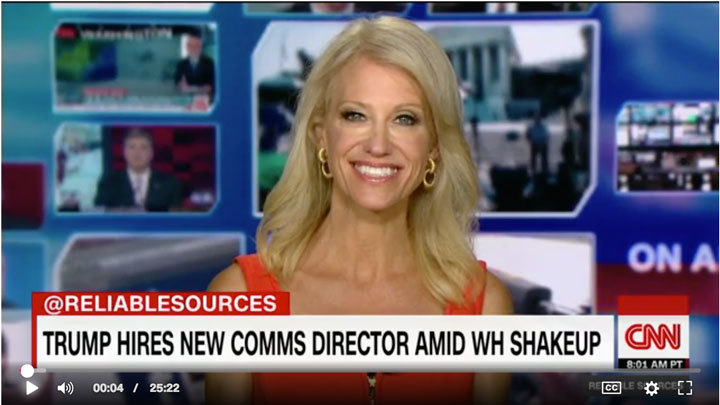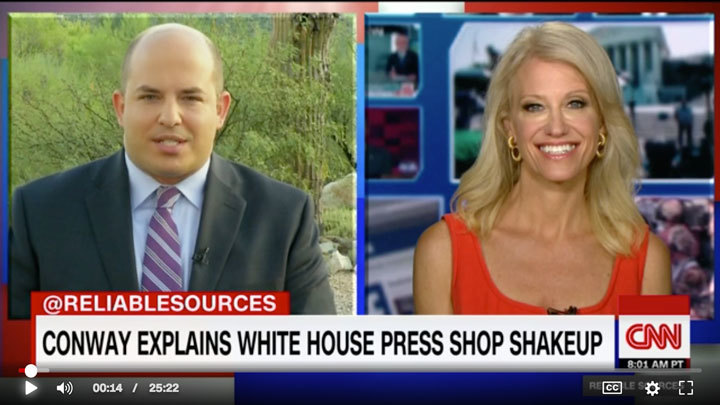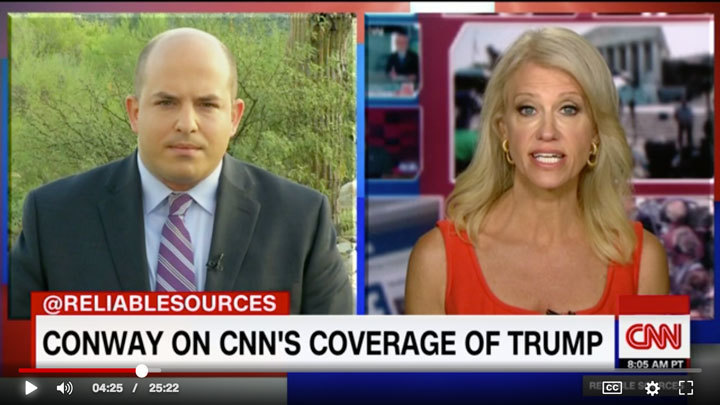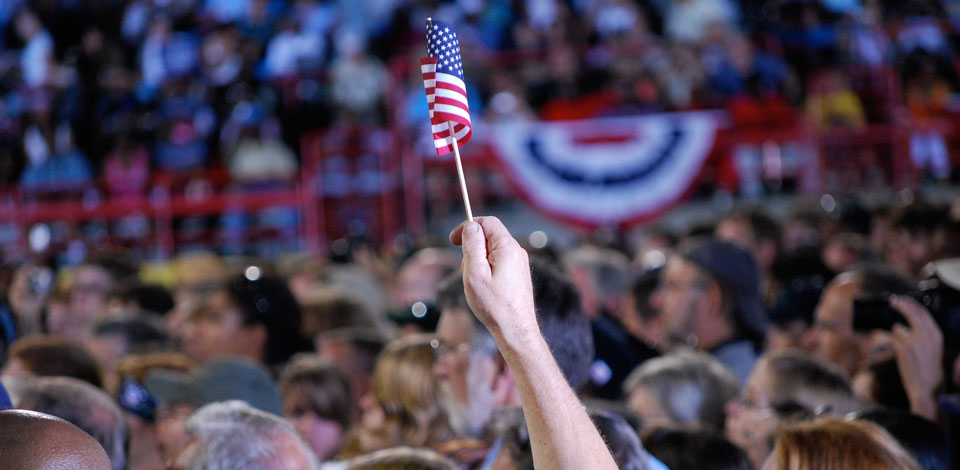[Also published at Huffington Post.] White House counselor Kellyanne Conway and “Reliable Sources” host Brian Stelter had a widely anticipated debate Sunday about the fairness of media coverage of the Trump administration. On every point that came up, Stelter exposed Conway as, at best, misleading.
And yet to some viewers, she was the clear winner.

How? Stelter and Conway were playing entirely different games.
For Conway, the audience was President Trump and the 36 percent of Americans who still trust him. Speaking past Stelter and connecting with them, she followed the rules of a game defined back in the 60s by the media consultants of the 1968 Nixon for President campaign.
One of them was the eventual founder of Fox News, Roger Ailes. Here’s Ailes in 1970, explaining why Nixon was seen to have lost his 1960 TV debate with John F. Kennedy despite many people believing he had won on the merits:
I think that the lighting was bad. It was experimental at best and sloppily done. His makeup was bad. I think he was tired–and this may have shown in his reaction and response.
I think that before the debates, John Kennedy spent the entire day briefing himself and relaxing, concentrating on the TV encounter.
Mr. Nixon did not do that. He walked in and handled it as if it were any other telecast.
Mr. Nixon, in a sense, stuck to the old school of debating, looking at Mr. Kennedy. But Mr. Kennedy looked at the camera, because he was essentially talking not to his opponent but to the people at home, and he was able to establish a kind of communication between himself and the home viewer. [Emphasis added.]
Ailes, along with other media and advertising experts, coached Nixon to be far more effective on TV for his winning 1968 campaign, and during his time in the White House.
The rules they defined still apply, as you can see by analyzing the video of the Stelter-Conway interview. Let’s start with the splash frame from CNN.com:

Conway looks happy, relaxed, and confident, is well lit by studio lighting, and is wearing red, a power color.
Now let’s look at her in split screen with Stelter:

Oh oh. Just seconds in, and Stelter’s losing already.
How do we know? Let’s count the ways.
- Kelly is being shot straight on, so she can make direct eye contact through the camera with the viewer. Meanwhile Stelter is being shot from slightly above, so he has to look up. This unavoidably signals submissiveness, no matter what he’s saying. Our brains can’t help but make the unconscious connection: small, less powerful people look up at bigger, more powerful people.
- Stelter isn’t as well lit. Compared to Conway, he looks washed out. She, meanwhile, is being sculpted by highlights and eyelights.
- He’s wearing more muted colors, dominated by grey.
- He appears to be outside, in some random grassy environment (he was in Tucson, on the first day of a family vacation, according to his Twitter feed.) It feels like he’s both literally and symbolically on the outside, while she’s on the inside, in the impressive environment of a CNN studio.
- As you play the video, you’ll hear that his sound is weaker as well — and occasional bird tweets don’t help.
And so it goes throughout the interview. As Stelter tries to pin Conway down on one misdirection after another, she just moves blithely on to the next. And each of his sallies feels, I’m sorry to say, “low energy.” At pains to preserve the standards of civil discourse, he repeatedly reassures her of his respect, while she turns her responses into digs at him and CNN.
One example among many:
Stelter: “The scandals are about the president’s lies. About voter fraud, about wire-tapping, his repeated lies about those issues. That’s the scandal.”
Conway: “He doesn’t think he’s lying about those issues.”
It’s OK because he doesn’t think he’s lying? On the page, Conway’s response is ridiculous. But on TV, she looks and sounds unruffled and in control.
Stelter, on the other hand, comes across as alternately tentative, frustrated, and confused:

On TV, impressions are what matter much more than words — as Conway’s boss could tell you, you win by looking like you’re winning.
CBS correspondent Lesley Stahl has often told the story of how she learned this lesson from a Reagan administration official back in 1984. Here’s how she related it to Bill Moyers in a 1989 interview:
I did a piece that was-where I was quite negative, to be honest with you, about Reagan. And yet the pictures were terrific, and I thought they’d be mad at me, but they weren’t. They loved it. And the official outright said to me, “They didn’t hear you. Didn’t hear what you said. They only saw those pictures.” And what he really meant was it’s the visual impact that overrides the verbal.
And that’s what happened, yet again, here.



